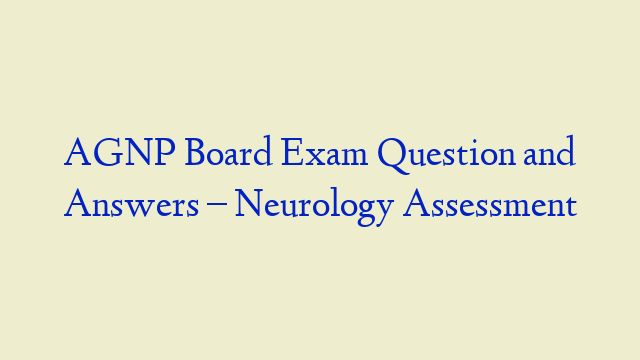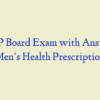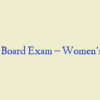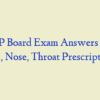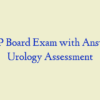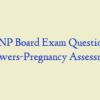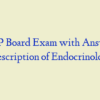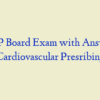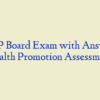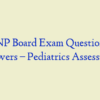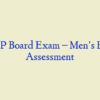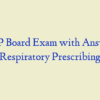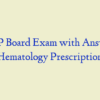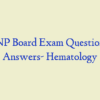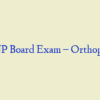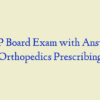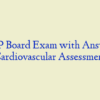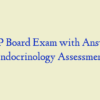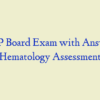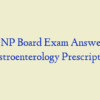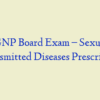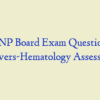Description
AGNP BOARD EXAM QUESTIONS Neurology Assessment (102 Questions)
- Which of the following medications is NOT a serotonin 5-HT1 receptor agonist?
- A patient presenting with a transient ischemic attack (TIA) is taking nifedipine (Adalat CC) for hypertension. Pharmacokinetics of nifedipine may be altered in patients with:
- Oxcarbazepine (Trileptal) is structurally similar to:
- Patients who experience greater than 7 to 9 tension-type headaches per month may be considered for maintenance therapy including:
- Beta-blockers, used for the prophylactic treatment of migraines, would NOT be contraindicated in a patient with a history of:
- Patients who are taking carbidopa/levodopa (Sinemet) for Parkinson’s disease should be advised to avoid a diet high in:
- Which of the following statements is NOT true about antiepileptic drugs (AEDs)
- Patients who are taking divalproex sodium (Depakote) and lamotrigine (Lamictal) are at higher risk for developing
- Children who are receiving gabapentin (Neurontin) should be monitored for:
- During initiation of treatment and escalation of doses, pramipexole (Mirapex) and other dopamine agonists are known to cause:
- Sumatriptan (Imitrex), a serotonin (5-HT1) receptor agonist, is:
- Patients who require oral corticosteroids for the treatment of Bell’s Palsy should be instructed to take the medication:
- To be of greatest benefit, corticosteroids in the treatment of Bell’s palsy should be initiated within:
- Beta-blockers are contraindicated in patients with
- Ropinirole (Requip), used in the treatment of restless legs syndrome (RLS), is metabolized primarily in the:
- Which of the following medications is an N-methyl-D-aspartate receptor antagonist for the treatment of dementia of the Alzheimer’s type?
- The most common short-term adverse effects of ropinirole (Requip) used in restless leg syndrome (RLS) include:
- Carbidopa/levodopa (Sinemet) for the treatment of Parkinson’s disease is contraindicated in patients with:
- Pramipexole (Mirapex), a dopamine agonist, is indicated in the treatment of:
- Exercise caution before initiating pregabalin (Lyrica) in combination with:
- The first-line treatment in acute tension-type headache i
- Triptans, such as sumatriptan (Imitrex), should NOT be administered concomitantly with:
- The brand name of oxcarbazepine is:
- The first-line pharmacological option for the treatment of generalized tonic-clonic seizures is:
- The most common side effects related to benztropine (Cogentin) and trihexyphenidyl, used in the treatment of parkinsonism, are:
- Education for patients who are taking amantadine should NOT include:
- The generic name for Depakote is:
- The primary beta-blocker indicated for the prophylactic treatment of migraine headaches is
- A patient who is receiving divalproex sodium (Depakote) reports acute abdominal pain accompanied by nausea and vomiting. This patient should be evaluate for:
- At each follow-up visit for patients who are taking carbidopa/levodopa (Sinemet), the provider should specifically inquire about
- A patient who is taking beta-blockers for the prophylactic treatment of migraine headache does NOT need to be monitored for:
- Macrolides, such as clarithromycin (Biaxin), are NOT generally use to treat:
- Amantadine, an antiviral agent and an N-methyl-D-aspartate (NMDA) receptor antagonist, is indicated in the treatment of:
- A pediatric patient who is taking valproic acid (Depakene) may exhibit toxicity symptoms which would include:
- Phenobarbital, indicate for the treatment of epilepsy, is:
- Divalproex sodium (Depakote) for the prophylactic treatment of migraines
- The brand name for levetiracetam is
- Pregabalin (Lyrica) is NOT approve for the treatment of:
- The mechanism of action of pramipexole (Mirapex) is to:
- Patients receiving non-cardioselective beta blockers for migraine treatment are much more likely to experience:
- Levetiracetam (Keppra), indicated in the adjunctive treatment of partial seizures, is:
- Oral levetiracetam (Keppra) is indicate for use as:
- Carbidopa/levodopa (Sinemet) for the treatment of Parkinson’s disease is a(n):
- The most common reason patients discontinue use of pregabalin (Lyrica) is
- Ergotamine alkaloids, such as dihydroergotamine (Migranal), are indicate in the treatment of:
- Patients taking topiramate (Topamax) are at high risk for developing:
- A patient was start on lamotrigine (Lamictal) 4 weeks ago, and today presents with a mild rash on the upper left thigh. The nurse practitioner should:
- Carbamazepine (Tegretol), use in the treatment of trigeminal neuralgia,:
- For treatment of Bell’s palsy, combination therapy is consider to be more beneficial and includes corticosteroids plus:
- The medication recommend for the rescue of refractory or cluster seizure activity is:
- To prevent further events, patients with transient ischemic attacks (TIAs) should be treated with
- A patient who is taking valproic acid (Depakote) should have routine laboratory monitoring which includes a:
- Serotonin (5HT1) receptor agonists, or triptans:
- Primidone (Mysoline) is metabolize into two active metabolites, one of which is:
- The brand name for carbamazepine is
- A drug interaction may occur between carbamazepine (Tegretol) and:
- The brand name of phenytoin sodium is
- The patient who requires the LEAST cautionary measures when treat with carbidopa/levodopa (Sinemet) is:
- Ergotamine alkaloids for the treatment of migraines are safe to administer with:
- Taking a triptan (5-HT1 agonist), such as sumatriptan (Imitrex), early in the headache cycle does NOT:
- Carbidopa and levodopa are the active ingredients in Sinemet use to treat Parkinson’s disease. The addition of carbidopa:
- Which medication may be beneficial in the treatment of restless legs syndrome (RLS)?
- Ticlopidine (Ticlid), a platelet aggregation inhibitor,
- Butalbital, one of the components of Fioricet, a medication used to abort tension-type headaches:
- Acetaminophen may be use to reduce fever in the presence of a febrile seizure. A severe complication of acetaminophen (Tylenol) is:
- Acute tension-type headaches refractory to simple analgesics may respond to a combination of analgesics and
- Which medication does NOT have an indication for the treatment of Parkinson disease?
- The medication class that does NOT lead to postural hypotension and possible syncope is:
- After initiation of 300 mg serum phenytoin (Dilantin), daily levels should be checked at approximately:
- The generic name for Lyrica is
- Non-selective beta-blockers used in migraine prophylaxis actively compete for beta receptors, inhibiting the binding of
- Benztropine (Cogentin), an anticholinergic, is NOT recommend for use in patients with
- A patient who is taking carbamazepine (Tegretol) for trigeminal neuralgia presents with complaints of fatigue, muscle cramps and nausea. These are symptoms of:
- Chronic use of phenytoin (Dilantin) has been associate with:
- Sumatriptan (Imitrex) is classified as a(n):
- Due to increase cholinergic activity in patients treate with donepezil (Aricept), patients should be monitor for:
- Patients who are taking rasagiline (Azilect) for the treatment of Parkinson’s disease should avoid other CYP1A2 inhibitors such as:
- Patients receive oxcarbazepine (Trileptal) should be routinely monitored for:
- Fioricet, indicate for the abortive treatment of tension-type headache, is a combination of acetaminophen,:
- Which of the follow is a non-dihydropyridine calcium channel blocker?
- Monitoring for side effects of topiramate (Topamax) includes: (AGNP BOARD EXAM QUESTIONS Neurology Assessment)
- Patients with mild chronic obstructive pulmonary disease may receive a beta-blocker for migraine prophylaxis as long as they are not currently taking a(n)
- Propranolol hydrochloride (Inderal) for the treatment of migraines
- A patient receiving lamotrigine (Lamictal) for the treatment of epilepsy would NOT need routine monitoring of:
- In addition to the treatment of various forms of epilepsy, lamotrigine (Lamictal) is indicated in the treatment of:
- Syncope related to vasovagal symptoms is best treat with:
- Common side effects relate to pregabalin (Lyrica) include:
- Clopidogrel (Plavix) is consider. (AGNP BOARD EXAM QUESTIONS Neurology Assessment)
- Clindamycin (Cleocin) is NOT indicate in the treatment of:
- Which medication is approve for prophylactic treatment of migraine headaches
- Follow an acute overdose of acetaminophen (Tylenol), patients who are at significant risk for hepatotoxicity should receive:
- Monitoring of patients receivegabapentin (Neurontin) should include:
- Medications with significant anticholinergic properties, such as amantadine (Symmetrel) to treat Parkinson’s disease, block which neurotransmitter? (AGNP BOARD EXAM QUESTIONS Neurology Assessment)
- Donepezil (Aricept), a cholinesterase inhibitor, is indicate in the treatment of
- The pharmacological management that provides the greatest clinical improvement of carpal tunnel syndrome is:
- Carbamazepine (Tegretol) is indicate in the treatment of:
- Divalproex sodium (Depakote) for the treatment of epilepsy can be safely administer to
- A medication used in a patient with a transient ischemic attack to prevent platelet aggregation and produce an anti-inflammatory effect in vessels by inhibiting prostaglandin synthesis is:
- Topiramate (Topamax), an antiepileptic drug,:
- The LEAST important goal of pharmacologic therapy in the treatment of epilepsy is to:
- A common adverse reaction to clopidogrel (Plavix) is:
- Patients receiving levetiracetam (Keppra) are NOT likely to experience the side effect of:
- Check out our latest courses on PSYC 502 Week 3.
